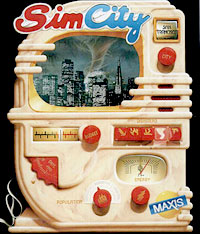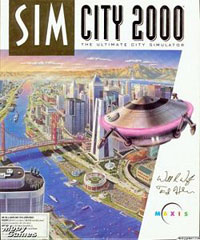 Tiredness? Sore eyes? Headache? Forget Lemsip and Clarityn. The best way to clear all these symptoms is to remove Sim City from your hard drive.
Tiredness? Sore eyes? Headache? Forget Lemsip and Clarityn. The best way to clear all these symptoms is to remove Sim City from your hard drive.
So what’s going on here. Well, the early versions – and it was originally designed for the Commodore 64 back in 1857 – were a flat bird’s eye view of a simulated city (do you see?) in which the player could apportion land to industrial, residential or commercial activity. The zones then build themselves, and then flourish or not according to how astute the player (ie Mayor) had been in planning the layout in the first place. This initial version was called Micropolis, and the creator – Will Wright – was inspired by a short story entitled ‘The Seventh Sally’ by Stanislaw Lem, in which a tyrant is given a tiny artificial city to oppress. Because of the non-winnable nature of the game, it was ignored by the industry at large until 1989, when the-size-of-a-dining-room-table software minnows Maxis picked it up and republished it as Sim City.
Like all the major franchise games, it has various versions, but essentially has not changed at all. You start with a flat (or landscaped to however you want it to look) piece of land, and you build a city on it. Remembering the golden rules for starting up – industrial land should equal same as residential and commercial combined, get everything supplied with water and electricity and chuck a primary school in for good luck – your city starts to grow. It actually does appear to literally grow too – you can zoom right in and see individual construction workers hammering away at scaffolding, reading the Sun or shouting into mobile phones in Latvian in some versions – and it is genuinely heart warming. It’s an altogether gentler buzz to the Championship Manager rollercoaster we spoke about last week, but absolutely no less addictive. It’s like watching the most interesting fish tank in the world.
 The level of Godness you have in your city is total. From setting up after school reading clubs for your future boffins, to embarking on a fifty year education strategy aimed at making sure your city is ready for the microchip age when it arrives (your city always starts in 1900) – you decide everything. Fortunately, you have what amounts to local government representatives who will suggest where tax revenue should be spent. Yes. Tax revenue. Tax your Sims (which is what they are called in the game, with the currency being the slightly jarring Simoleon) too heavily and they’ll up sticks and leave. Tax them too low, and nothing gets built and your city goes bankrupt. Your population can demand pretty specific things too – I once inadvertently caused major rioting in a largish city by failing to provide adequate marina facilities.
The level of Godness you have in your city is total. From setting up after school reading clubs for your future boffins, to embarking on a fifty year education strategy aimed at making sure your city is ready for the microchip age when it arrives (your city always starts in 1900) – you decide everything. Fortunately, you have what amounts to local government representatives who will suggest where tax revenue should be spent. Yes. Tax revenue. Tax your Sims (which is what they are called in the game, with the currency being the slightly jarring Simoleon) too heavily and they’ll up sticks and leave. Tax them too low, and nothing gets built and your city goes bankrupt. Your population can demand pretty specific things too – I once inadvertently caused major rioting in a largish city by failing to provide adequate marina facilities.
And then there’s the proles. No matter how hard you try and build a pollution free city with a highly educated population using the hugely expensive, efficient and excellently integrated public transport network you have provided, you are still likely to get nasty slum areas. These often arise where your city first flourished, as most cities are founded on heavy industry employing unskilled and progressively unhealthy workers who don’t have the income or inclination to build lovely spacious homes with billiard rooms and swimming pools. However, the tax that they and their employers are paying enables you to zone less dense residential land a long way away from the smog where your new, white collar citizens can live. You get loads of them. They cause massive traffic jams on the arterial roads with their pesky private transport. You chuck a rail network in to ease traffic. They won’t use it. Why? Because there are no car parks near the railways stations for them to drive to. They start to move out of the nice areas you have zoned for them, which get swallowed up by slums. Rather like the Ceaser series, which is a scenario driven Roman version of the game different enough to not actually be a rip off, you very often end up bulldozing huge swathes of lower class housing to provide luxury flats and leisure facilities for your top 10% of desirable citizens. It’s exactly what is happening in Stratford, East London, at this very minute, in fact. That’s the thing with Sim City – it is exactly like real life. They should just call it ‘City’.
Sim City is a rather strange concept for a computer game, what with not actually being a game at all. Yes, it has goals within the gameplay and goals that you’ll set yourself as you play, but you never actually win. You can certainly lose, however, in the form of terminal civic bankruptcy. Based on that premise, it’s enough to have you reaching for the telly guide. The only real plus point for the Sim City franchise is that it’s one of the most brilliantly devised and balanced pieces of software programming in the history of the microprocessor. Lucky, that. Enjoy.

Comments are closed.